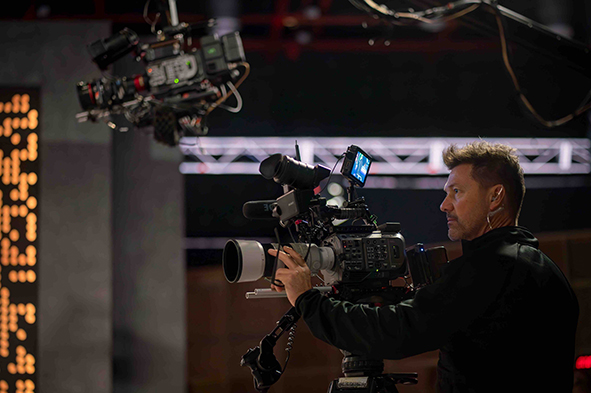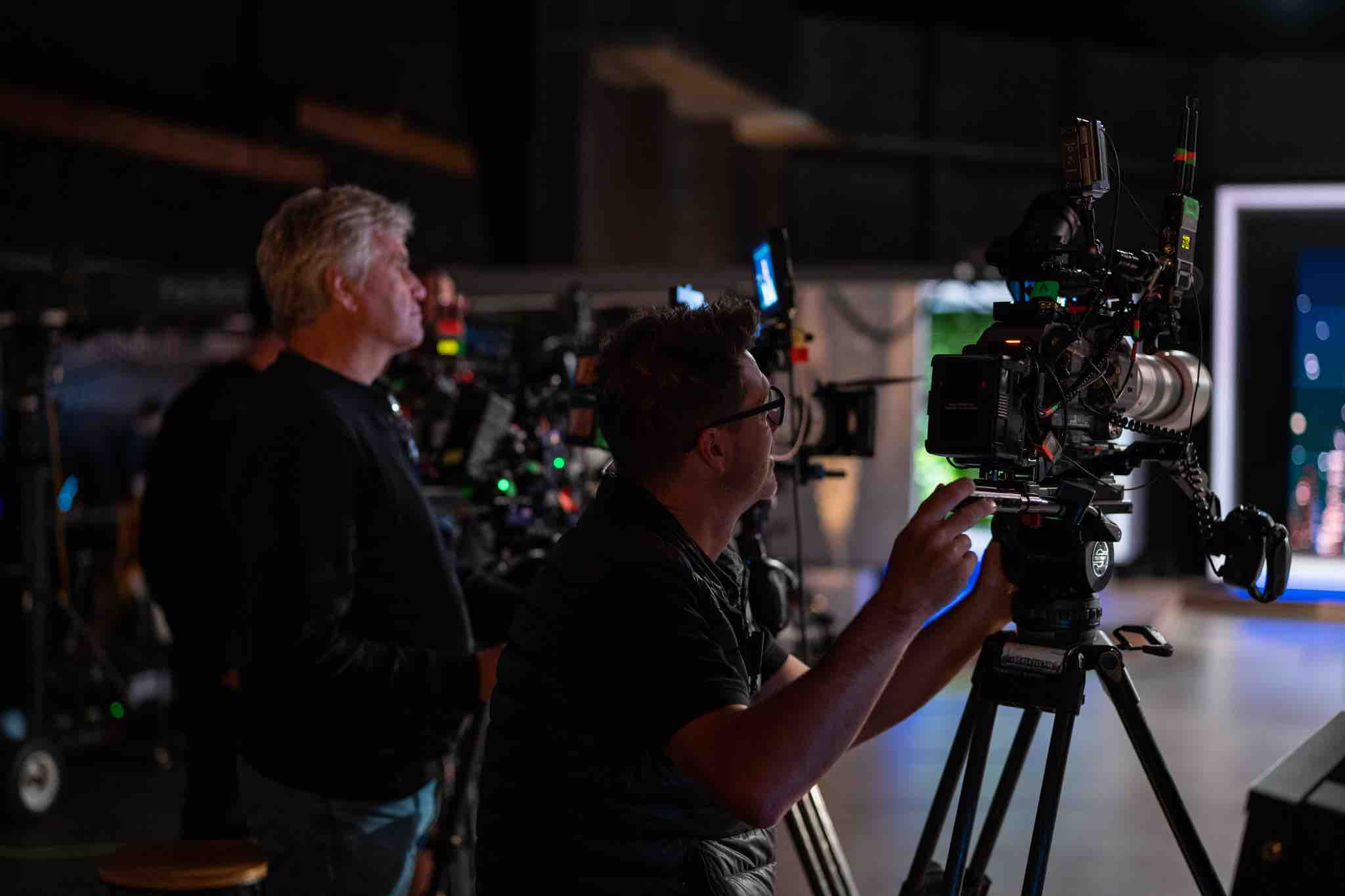Tim Hawkins Shoots All Full Frame on Shark Tank Australia with Sony Cameras
Story Highlights
In the upcoming Network 10 and Paramount+ series Shark Tank Australia, the smart entertainment television show – made by production company Curio Pictures – that highlights everyday Australians and their exceptional ideas, DoP Tim Hawkins has created a unique look and workflow by exclusively shooting the series with 16 full frame Sony PXW-FX9, ILME-FX6V and ILME-FR7 cameras – all using Sony lenses.

Tim Hawkins shooting on the set of Shark Tank Australia
Hawkins explains, “Shooting Shark Tank Australia has been an amazing experience and it’s been one of the trickiest shoots of my 30-year career. We had a bunch of full frame challenges in preproduction and whilst it’s not been easy, I’ve proved it can be done. I have received huge support from our EP – Jemma Carlton, Line Producer- Jo Cadman and Director – Peter Lawler, as they also wanted to have a full frame look for the series and by using the Sony FX9, FX6 and FR7 cameras the end results are spectacular.”
Shark Tank Australia is Hawkins’ first large format series after shifting his focus to documentary films four years ago.
He adds, “I have been a long-term user of Sony cameras and products. In fact, this year for me celebrates 30 years of continuous Sony camera use. I’ve owned a few other cameras over the years but there’s always been a professional Sony camera in my bag. In truth, shooting Shark Tank Australia is actually two FF stories that include the Sony FR7 PTZ camera, how it filled a gap and solved a huge problem for me as a DoP when shooting a large format studio show on full frame (FF) sensors.”
The Sony ILME-FR7 PTZ camera shooting on the set of Shark Tank Australia
Hawkins is a big believer in Sony FF cameras. He was an early adopter of the FX series cameras and loves the versatility and tech in them.
He continues, “As a DOP, my problem has been that until now there wasn’t a Pan Tilt Zoom (PTZ) camera that used a FF sensor. Often the only practical option on a TV series is to use PTZ cameras. It’s not ideal but practically using PTZ cameras is often a good solution to capturing content in tricky locations. My problem has always been matching the PTZ cameras with my large sensor FF cine cameras. Often the better solution when having PTZ cameras on set is to lower the quality of the main ENG cameras to more closely match the PTZ cameras, so the viewer isn’t visually jolted when cutting between them. The announcement of the Sony FR7 gave me hope we could have a large multi-camera TV series shot entirely on FF cameras and it proved to be 100% the case on Shark Tank Australia.”
Once green lit, Hawkins and his crew took some brand new FR7 cameras and began unboxing, stickering and integrating them with his FX9 and FX6s on the Shark Tank Australia set at Disney Studios in Sydney adding, “Ideally, I wouldn’t have had three different cameras on set as a single camera model makes life simple. For me, the FX9 and FX6 are different cameras. I own them both and love them equally. I interchange them on set all the time and was very confident if I played my cards right I could have them look the same. Further to that, I believed that having both FX9s and FX6’s together would help and be an asset to the series.”
Hawkins ended up using a full Sony G Master solution for lenses explaining, Preproduction was hectic, there was a flurry of lens changes with us all trying to make the most of those FF sensors as well as giving the coverage asked for.”
Shark Tank Australia is shot on a massive studio set and the series’ director, Pete Lawler, wanted close ups from some of the floor cameras while a Techno Jib and Steady Cam was shooting wides on the fly.
Hawkins says, “This required our floor cameras to be way at the back of the studio. I tried a bunch of long zoom lenses but wasn’t keen with the look of those at the long end. Some were slow and others didn’t look cinematic enough whilst others physically couldn’t be manually zoomed on-air and were ruled out. So, for the hard cameras, I landed back at our trusty Sony 70-200mm GM2s with 1.4 times teleconverter behind the lens. I placed the FX6s in the positions that required the tightest shots and got them to use clear image zoom when required. I reckon using that combo gave us close to +400mm on the FX6s and +300mm on the FX9s in S35.”
Three of the FR7s used the Sony 28-135mm lens, one FR7 had a Sony FE 16-35mm T3.1 G and another ran a 14mm prime. All had clear image zoom engaged and gave Hawkins a great cinematic look while still being able to remotely pan, tilt and zoom the lenses.
The Techno Jib had a 17-120mm CNE lens and the Steady Cam used a combination of Fujinon Cabrio 19-90mm, Sigma 50mm and Sony 85mm and 50mm lenses.
Hawkins also had eight FX9 and FX6 hard cameras on tripods, placed an FX6 on the Steady Cam and an FX9 on the Techno Jib. The FR7 PTZ cameras were then integrated into the set to obtain shots in areas the hard cameras couldn’t get to.
The full frame element of the Sony cameras was critical but not without its challenges on Shark Tank Australia as Hawkins explains, “Being able to bring a beautiful cinematic look to a series is most modern DoPs’ goal and it’s certainly mine. To be honest, it can be problematic having FF cameras on large multi-camera shoot. On Shark Tank Australia we ended up with 16 FF cameras. That gave us beautiful looking images and made preproduction far more interesting than usual. Having FF cameras on a studio show like Shark Tank Australia is a game changer look-wise so, yeah, it was very important but challenging. Luckily both the EP and director were very supportive and backed me.”
Shark Tank Australia is essentially a static show. The “Sharks” are seated while the entrepreneur pitches often in a static standing position. The floor hard cameras capture the main content with a Techno Jib, Steady Cam and 6m cine slider bringing movement to the coverage. To add in additional movement Hawkins made sure the back of stage shots – before and after the pitch – were shot handheld.
Other challenges presented themselves around the fact that all three cameras have different base ISOs and all three of them have different noise ratios in their base ISOs.
Hawkins adds, “I solved one of our biggest workflow issues by adopting S-Cinetone to the base look of all cameras. Shark Tank Australia is a completely controlled studio show and shooting in S-Cinetone gave me back full control of the cameras. I love the look of S-Cinetone and use it often. Usually S-Log 3 is my go-to look for the Sony cameras, but in this situation S-Cinetone allowed me to solve some of our pre-production challenges in-camera. S-Cinetone gave me power to decide in-studio not only the look of the show but base-ISO, noise levels and ISO levels. We were also able to fine tune the colour of the cameras and match the colour balance and exposure perfectly. An impossible task if we’d chosen a Log solution. Everyone knew S-Cinetone was placing control back in my hands and again, I could not have felt more trusted and supported in that decision by our EP and director.”
One of Hawkins’ non-negotiable criteria for Shark Tank Australia was shooting with his lenses wide open. All cameras had to be wide open at all times. Ultimately, in order to achieve this, he used a large range of solutions that involved internal and external ND filters, ISO changes and lighting solutions.
Hawkins says, “We lit the studio somewhere close to F2.8 and I had a bunch of F4 lenses on some cameras, some F2.8 lenses and one variable aperture zoom lens. It was fairly low light, so I needed to push the sensitivity of the sensors without introducing too much noise. I knew the FX6 had noise in its high base ISO while the FX9 is clean as a whistle in high base ISO. I had no idea on the Sony FR7 noise levels as they were brand new into the country and I had no reference points, as I didn’t know anyone else who had used the FR7s in this way in Australia.”
He continues, “Initially it was a real juggle and at times we had many balls in the air but ultimately, thinking broadly and trusting the Sony cameras gave us the look we were after without compromising. No camera is perfect, but you have to hand it to the Sony FX series cameras for their versatility. When understood correctly, they are very powerful cameras and the FR7 is a great inclusion to their family. The FX series cameras enable me to deliver different looking content with the same camera for various clients on any given day.”
When reflecting on the size, scale and sheer sense of achievement within the production of Shark Tank Australia Tim Hawkins concludes, “As I said at the beginning, shooting Shark Tank Australia has been an amazing and challenging experience. That said we have much to thank the Sony FX6, FR7 and FX9 cameras for, as they helped us achieve such a great result. I love of the tech in the Sony FX series cameras and I’m always talking about it. Whether it’s the auto focus, variable ND, hi/low base ISO, sensor crop functions, frame rates, codecs or the low light capabilities the tech has changed my life and I’m a better DOP for it. Finally, being able to integrate Sony full frame PTZ cameras into a full frame studio show is still very new. One thing is for certain, having those FR7s gave us a great edge and an amazing look.”
